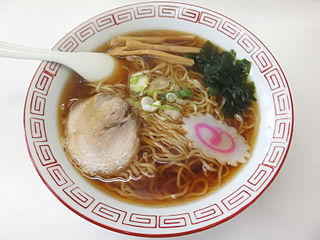
Thai cuisine is the national cuisine of Thailand.

Ramen is a Japanese noodle dish of Chinese origin. It consists of Chinese-style wheat noodles served in a broth; common flavors are soy sauce and miso, with typical toppings including sliced pork, nori, menma, and scallions. Ramen has its roots in Chinese noodle dishes and is a part of Japanese Chinese cuisine. Nearly every region in Japan has its own variation of ramen, such as the tonkotsu ramen of Kyushu and the miso ramen of Hokkaido.

Noodle soup refers to a variety of soups with noodles and other ingredients served in a light broth. Noodle soup is a common dish across East Asia, Southeast Asia and the Himalayan states of South Asia. Various types of noodles are used, such as rice noodles, wheat noodles and egg noodles.

Fried noodles are common throughout East Asia, Southeast Asia and South Asia. Many varieties, cooking styles, and ingredients exist.

Korean Chinese cuisine, also known as Sino–Korean cuisine, is a hybrid cuisine developed by the ethnic Chinese in Korea.

Chili sauce and chili paste are condiments prepared with chili peppers.

Japanese Chinese cuisine, also known as chūka, represents a unique fusion of Japanese and Chinese culinary traditions that have evolved over the late 19th century and more recent times. This style, served predominantly by Chinese restaurants in Japan, stands distinct from the "authentic Chinese food" found in areas such as Yokohama Chinatown. Despite this difference, the cuisine retains strong influences from various Chinese culinary styles, as seen in the shippoku cooking style.

Mie goreng, also known as bakmi goreng, is an Indonesian stir-fried noodle dish. It is made with thin yellow noodles stir-fried in cooking oil with garlic, onion or shallots, fried prawn, chicken, beef, or sliced bakso (meatballs), chili, Chinese cabbage, cabbages, tomatoes, egg, and other vegetables. Ubiquitous in Indonesia, it is sold by food vendors from street hawkers (warungs) to high-end restaurants.

Tteokbokki (Korean: 떡볶이), or simmered rice cake, is a popular Korean food made from small-sized garae-tteok called tteokmyeon or commonly tteokbokki-tteok. Eomuk, boiled eggs, and scallions are some common ingredients paired with tteokbokki in dishes. It can be seasoned with either spicy gochujang or non-spicy ganjang -based sauce; the former is the most common form, while the latter is less common and sometimes called gungjung-tteokbokki.

Javanese cuisine is the cuisine of Javanese people, a major ethnic group in Indonesia, more precisely the province of Central Java, Yogyakarta and East Java.
Samyang Roundsquare Co., Ltd. is an international South Korean food manufacturer and the first instant ramen company in South Korea. Samyang was founded on September 15, 1961 by Jeon Jung Yoon. In 1963, Samyang debuted the first Korean instant noodle.

Manchurian is a class of Indian Chinese dish made by roughly chopping and deep-frying ingredients such as chicken, cauliflower (gobi), prawns, fish, mutton, and paneer, and then sautéeing them in a sauce flavored with soy sauce. Manchurian is the result of the adaptation of Chinese cooking and seasoning techniques to suit Indian tastes. It has become a staple of Indian Chinese cuisine.

Mala is a spicy and numbing seasoning made from Sichuan peppercorn and chilli. Most commonly, mala is made into a sauce by simmering it in oil and other spices. Characteristic of Sichuan cuisine, particularly Chongqing cuisine, it has become one of the most popular ingredients in Chinese cuisine, spawning many regional variants.

Hot Chicken Flavor Ramen or buldak-bokkeum-myeon is a South Korean brand of instant noodle, produced by Samyang Foods since April 2012.

Cup noodle is a registered trademark of Nissin Foods and is known as precooked instant noodles with flavoring powder and/or seasoning sauce sold in a polystyrene, polyethylene, or paper cup. The flavoring can be in a separate packet or loose in the cup. Hot water is the only ingredient that is needed separately. Cooking takes 3–5 minutes. Now, many kinds of precooked instant noodle have been consumed around the world, as a popular staple.

Indonesian noodles are a significant aspect of Indonesian cuisine which is itself very diverse. Indonesian cuisine recognizes many types of noodles, with each region of the country often developing its own distinct recipes.















